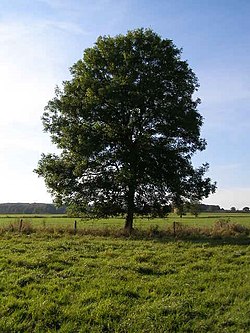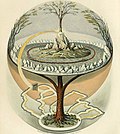Portal:Trees
The Trees Portal

In botany, a tree is a perennial plant with an elongated stem, or trunk, usually supporting branches and leaves. In some usages, the definition of a tree may be narrower, e.g., including only woody plants with secondary growth, only plants that are usable as lumber, or only plants above a specified height. But wider definitions include taller palms, tree ferns, bananas, and bamboos.
Trees are not a monophyletic taxonomic group but consist of a wide variety of plant species that have independently evolved a trunk and branches as a way to tower above other plants to compete for sunlight. The majority of tree species are angiosperms or hardwoods; of the rest, many are gymnosperms or softwoods. Trees tend to be long-lived, some trees reaching several thousand years old. Trees evolved around 400 million years ago, and it is estimated that there are around three trillion mature trees in the world currently.
A tree typically has many secondary branches supported clear of the ground by the trunk, which typically contains woody tissue for strength, and vascular tissue to carry materials from one part of the tree to another. For most trees the trunk is surrounded by a layer of bark which serves as a protective barrier. Below the ground, the roots branch and spread out widely; they serve to anchor the tree and extract moisture and nutrients from the soil. Above ground, the branches divide into smaller branches and shoots. The shoots typically bear leaves, which capture light energy and convert it into sugars by photosynthesis, providing the food for the tree's growth and development.
Trees usually reproduce using seeds. Flowering plants have their seeds inside fruits, while conifers carry their seeds in cones, and tree ferns produce spores instead.
Trees play a significant role in reducing erosion and moderating the climate. They remove carbon dioxide from the atmosphere and store large quantities of carbon in their tissues. Trees and forests provide a habitat for many species of animals and plants. Tropical rainforests are among the most biodiverse habitats in the world. Trees provide shade and shelter, timber for construction, fuel for cooking and heating, and fruit for food as well as having many other uses. In much of the world, forests are shrinking as trees are cleared to increase the amount of land available for agriculture. Because of their longevity and usefulness, trees have always been revered, with sacred groves in various cultures, and they play a role in many of the world's mythologies. (Full article...)
The Webster Sycamore (alternatively known as the Webster Springs Sycamore and the Big Sycamore Tree) was an American sycamore (Platanus occidentalis) in the U.S. state of West Virginia. Long recognized for its size, the Webster Sycamore was the largest living American sycamore tree in West Virginia until its felling in 2010. The tree stood approximately 4.5 miles (7.2 km) east of Webster Springs in Webster County, in a moist flood plain along the banks of the Back Fork Elk River, a tributary stream of the Elk River.
The Webster Sycamore reached a tree height measurement of 112 feet (34 m), a tree crown measurement of 90 feet (27 m), and a circumference of 25.75 feet (7.85 m) at breast height. In 1955, the American Forests Association declared the tree the largest of its species in the United States. It only held the title for three weeks, before the association identified a larger American sycamore in Maryland. Despite losing its national title, the sycamore remained the largest American sycamore in West Virginia. Following a 1963 survey of large trees in West Virginia, the Webster Sycamore was named the second-largest tree after a white oak (Quercus alba) in Randolph County. (Full article...)
Did you know? -
- ... that fossil leaves almost identical to those of the Australian rainforest tree Orites excelsus (pictured) have been found in New Zealand?
- ... that more than 8000 trees were planted in Backmuir Wood to celebrate the 2000 millennium?
- ... that the name of the newly defined genus of macadamia-like trees, Lasjia, is derived from the initials of Lawrence Alexander Sidney Johnson?
- ... that at St Athan, a wild fig tree grew out of the cement of the East Orchard chapel walls?
- ... that in the churchyard of St Mary and St Peter's Church in Wilmington, East Sussex, there is a 1,600-year-old, 23-foot (7 m) wide yew tree?
- ... that Christopher Werner made a lifelike South Carolina Palmetto tree out of iron, copper, and brass?
- ... that seed from an endangered Chrysophyllum imperiale tree planted in Royal Botanic Gardens, Sydney in 1868 by Prince Alfred has been sent to its native Brazil to aid in recovering the species there?
Selected article -

Crataegus laevigata, known as the Midland hawthorn, English hawthorn, woodland hawthorn, or mayflower, is a species of hawthorn native to western and central Europe, from Great Britain (where it is typically found in ancient woodland and old hedgerows) and Spain, east to Romania and Ukraine. The species name is sometimes spelt C. levigata, but the original orthography is C. lævigata. (Full article...)
General images
Selected lists
Subcategories
Related portals
Associated Wikimedia
The following Wikimedia Foundation sister projects provide more on this subject:
-
Commons
Free media repository -
Wikibooks
Free textbooks and manuals -
Wikidata
Free knowledge base -
Wikinews
Free-content news -
Wikiquote
Collection of quotations -
Wikisource
Free-content library -
Wikispecies
Directory of species -
Wikiversity
Free learning tools -
Wiktionary
Dictionary and thesaurus

















































































